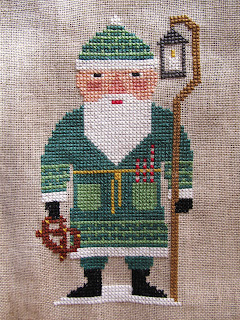Hey all. I was anxious to try the tip I received from Donna (from yesterday's post) so I purchased two interfacings that felt the most stiff. As soon as I came home, dried off from a massive soaking, and ate most of the Halloween candy, I went to work. And by the way....hot flash is no longer correct. Flash defines as quick and temporary. No no. These are drawn out endurance matches between every pore above the waist. Including eyebrows. On to sewing. Eureka!!! This may be old stuff to you but bear with me - I don't get excited often. I need to bake something for Donna when I take my blazers to her. Her advice made it so much easier, neater, and quicker. I'm certainly going to give it a go myself and see how the other fabrics work. Here's a recap of what I did. I used an old piece on Aida, stitched right sides together on three sides following the fabric threads. Then I cut a piece of the fusible interfacing to fit directly inside the stitched seam and  ironed the corner to secure. The other side was folded along the stitched seam line and then cut along the fold. It's quicker and more accurate than measuring.The open bottom end facing should be cut to where the seam should be, and the fabric can be pressed up over it for a neat finish, ready to be hand sewn closed.
ironed the corner to secure. The other side was folded along the stitched seam line and then cut along the fold. It's quicker and more accurate than measuring.The open bottom end facing should be cut to where the seam should be, and the fabric can be pressed up over it for a neat finish, ready to be hand sewn closed.
 ironed the corner to secure. The other side was folded along the stitched seam line and then cut along the fold. It's quicker and more accurate than measuring.The open bottom end facing should be cut to where the seam should be, and the fabric can be pressed up over it for a neat finish, ready to be hand sewn closed.
ironed the corner to secure. The other side was folded along the stitched seam line and then cut along the fold. It's quicker and more accurate than measuring.The open bottom end facing should be cut to where the seam should be, and the fabric can be pressed up over it for a neat finish, ready to be hand sewn closed.  Once the cuts were made, the facing was pressed and fused to the stitched fabric and also the backing fabric. I pressed the seam allowances open on all three sides which really gives a crisp seam, and clipped the corners, adding a drop of fabric glue to the edges, which isn't really necessary. When I turned it right side out I was amazed.
Once the cuts were made, the facing was pressed and fused to the stitched fabric and also the backing fabric. I pressed the seam allowances open on all three sides which really gives a crisp seam, and clipped the corners, adding a drop of fabric glue to the edges, which isn't really necessary. When I turned it right side out I was amazed. I always used a pin on the backing fabric to pull the corners out and with the facing, it made it easier. What a difference compared to when I fused lighter interfacing to the whole piece.
I always used a pin on the backing fabric to pull the corners out and with the facing, it made it easier. What a difference compared to when I fused lighter interfacing to the whole piece. 
 The bottom edges are pressed with a perfect straight edge, ready to be sewn, and stuffing this cavern was even easier! I didn't need as much and my corners were already good so there was no poking and prodding. The piece actually stood by itself, crisp as could be, before it was even filled.
The bottom edges are pressed with a perfect straight edge, ready to be sewn, and stuffing this cavern was even easier! I didn't need as much and my corners were already good so there was no poking and prodding. The piece actually stood by itself, crisp as could be, before it was even filled. So here is the ornament, ready to be stitched close in record time without the aggravation. I used to stitch across the bottom corners and leave an opening to turn and stuff, but this is so much easier. I imagine I could follow this method without stitching back to front. Just fuse and turn the seams in on each piece, and then hand sew shut on four sides, even attaching trim at the same time. This Aida was fused with the Craft Fuse #808 from Pellon, and Decor Bond #809 on a lighter fabric. Both of these worked very well.
As usual, you probably already know this! But I have to say I'm thrilled to discover this now. Thank goodness I asked her! I don't think it's a fluke that these test pieces came out so well and I'm expecting my Santas and other projects to finish as nicely. Jobelan is the Santa ornament fabric that I will be working on next and I doubt if I have any scraps left to test. I'm confident enough to just use the stitched piece. Hopefully, you'll be seeing a bunch of ornaments looking pretty fine!!! As I type this, Woody Wood****** is bringing in pieces of straw to the hole he just drilled, even though it's only as deep as the siding and not big enough to get in. I'm not sure what will break first - the window I keep pounding on or the fist pounding it.
Have a good week! Thanks for reading!!









































